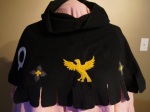Inspiration strikes at the oddest times. I was visting the Metropolitan Museum of Art with my husband and was walking around enjoying the exhibits when we stopped to look at a tapestry. It was pretty cool, having a harvest scene surrounded by the signs of the zodiac. I walked away, stopped and walked back, something catching my eye.
There was a pleated apron on one of the women in the tapestry. Not only that it was different than anything I had seen before. So I took a picture and continued on wandering around the museum. After I got home, I started looking at the few picture I took and there was the picture of the tapestry and that apron. I HAD TO MAKE IT!!
Now I have been making pleatwork aprons for almost 10 years. I own two, I have given piles away. I really dont need another one. So I put the call out to see if anyone wanted one if I made it. Well one of the people who answered happened to have a middle class Flemish persona (in the Society for Creative Anachronism). Her research has been in cooking. Who better to need and get an apron!!.
My challenge with this project was just trying to figure out what the heck was going on. The apron was a strange merger of what I consider a Flemish Apron (rectangle of fabric) and the pleatwork aprons that were a favored accessory in the Germanic areas during the 16th century.
What I found was more and more pictures of aprons. While I did not uncover another image that looked like this one, what I found were images of aprons that had various elements of my inspiration image. Once again, it all came together and a new apron was born.
This was my third entry in the Kings and Queens Arts and Science Competition for the East Kingdom of the SCA and the one I think was the most “fun”. I actually had to keep trying it on to show people all the fun elements. I have been accused of spreading apron fun through the SCA. If this is the influence I have had, then that is a good thing indeed. I mean really, who does not love a pretty fun accessory:)
As with the other projects, below is a link to the write up, and some pictures.
https://medievalhandwork.files.wordpress.com/2014/02/a-flemish-apron.pdf





























